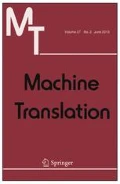Abstract
This paper shows the necessity of distinguishing different referential uses of NPs in Machine Translation. We propose a three- way distinction between the generic, referential and ascriptive uses of noun phrases (NPs), and argue that this is the minimum necessary to generate articles and number correctly when translating from Japanese to English. A detailed algorithm is proposed for determining the referentiality of Japanese NPs, based on a defeasible hierarchy of pragmatic rules that are applied top-down, from the clause to the NP. We also sketch the process of generating determiners and number using rules based on the different NP referentialities for a Japanese–English MT system. Using the proposed heuristics has raised the percentage of NPs generated with correct use of articles and number in the Japanese–English MT system ALT-J/E from 65% to 85%.
Similar content being viewed by others
References
Bond, Francis, Kentaro Ogura & Satoru Ikehara: 1994, ‘Countability and Number in Japaneseto-English Machine Translation’ in COLING 94: The 15th International Conference on Computational Linguistics, Kyoto, pp. 32–38.
Bond, Francis, Kentaro Ogura & Satoru Ikehara: 1995a, ‘Possessive Pronouns as Determiners in Japanese-to-English Machine Translation’ in 2nd Pacific Association for Computational Linguistics Conference: PACLING-95, Brisbane, pp. 32–38.
Bond, Francis, Kentaro Ogura & Satoru Ikehara: 1996, ‘Classifiers in Japanese-to-English Machine Translation’ in COLING-96: The 16th International Conference on Computational Linguistics, Copenhagen, pp. 125–130.
Bond, Francis, Kentaro Ogura & Tsukasa Kawaoka: 1995b, ‘Noun Phrase Reference in Japaneseto-English Machine Translation’ in Proceedings of the Sixth International Conference on Theoretical and Methodological Issues in Machine Translation TMI 95, Leuven, Belgium, pp. 1–14.
Bond, Francis, Kentaro Ogura & Hajime Uchino: 1997, ‘Temporal Expressions in Japanese-to-EnglishMachine Translation’ in Proceedings of the 7th International Conference on Theoretical and Methodological Issues in Machine Translation, Santa Fe, New Mexico, pp. 55–62.
Briscoe, Ted, Valeria de Paiva & Ann Copestake (eds): 1993, Inheritence, Defaults and the Lexicon, Cambridge: Cambridge University Press.
Carlson, Gregory & Francis Pelletier: 1996, The Generic Book, Chicago: University of Chicago Press.
Chesterman, Andrew: 1991, On Definiteness: A Study with Special Reference to English and Finnish, Cambridge: Cambridge University Press.
Cornish, Tim, Kimikazu Fujita & Ryochi Sugimura: 1994, ‘Towards Machine Translation using Contextual Information’ in 15th International Conference on Computational Linguistics: COLING-94, Kyoto, pp. 51–56.
Declerk, Renaat: 1988, Studies on Copular Sentences, Clefts and Pseudo-clefts, Leuven, Belgium: Leuven University Press.
Ehara, Terumasa & Hozumi Tanaka: 1993, ‘Kikai hon'yaku ni-okeru shizen gengo shori (Natural Language Processing in Machine Translation)’ Jōhō Shori Gakkaishi (Journal of Information Processing Society of Japan) 34, 1266–1273.
Gawron, Jean Mark & Stanley Peters: 1990, Anaphora and Quantification in Situation Semantics, Stanford, CA: Center for the Study of Language and Information.
Heine, Julia: 1997, Ein Algorithmus zur Bestimmung der Definitheitswerte japanischer Nominalphrasen, Diplomarbeit, Universität des Saarlandes, Saabrücken, Germany.
Huddleston, Rodney: 1984, Introduction to the Grammar of English, Cambridge: Cambridge University Press.
Huddleston, Rodney: 1988, English Grammar: An Outline, Cambridge: Cambridge University Press.
Ikehara, Satoru, Masahiro Miyazaki, Satoshi Shirai, Akio Yokoo, Hiromi Nakaiwa, Kentaro Ogura, Yoshifumi Ooyama & Yoshihiko Hayashi: 1997, Goi-Taikei - A Japanese Lexicon, Tōkyō: Iwanami Shōten, 5 volumes.
Ikehara, Satoru, Satoshi Shirai & Francis Bond: 1996, ‘Approaches to Disambiguation in ALT-J/E’ in International Seminar on Multimodal Interactive Disambiguation: MIDDIM-96, Grenoble, France, pp. 107–117.
Ikehara, Satoru, Satoshi Shirai & Kentaro Ogura: 1994, ‘Gengo hyōgen taikei-no chigai-ni chakumoku-shita nichi-ei kikai hon'yaku kinō shiken kōmoku-no kōsei (Criteria for Evaluating the Linguistic Quality of Japanese to English Machine Translations)’ Jinkō Chinō Gakkaishi (Journal of Japanese Society for Artificial Intelligence) 9, 569–579.
Ikehara, Satoru, Satoshi Shirai, Akio Yokoo & Hiromi Nakaiwa: 1991, ‘Toward an MT System without Pre-Editing - Effects of New Methods in ALT-J/E’ in MT Summit III, Washington, DC, pp. 101–106.
Knight, Kevin & Ishwar Chander: 1994, ‘Automated Postediting of Documents’ in Proceedings of the 12th National Conference on Artificial Intelligence: AAAI-94, Seattle, WA, pp. 779–784.
Kuno, Susumu: 1973, The Structure of the Japanese Language, Cambridge, Mass: MIT Press.
Levin, Beth: 1993, English Verb Classes and Alternations, Chicago: University of Chicago Press.
Murata, Masaki: 1996, ‘Anaphor Resolution in Japanese Sentences Using Surface Expressions and Examples’ Ph.D. thesis, Kyoto University.
Murata, Masaki, Sadao Kurohashi & Makoto Nagao: 1996, ‘Hyōsō hyōgen-o tegakari-to-shita nihongo meishiku-no shijisei-to sū-no suitei (An Estimate of Referential Property and Number of Japanese NPs from Surface Expressions)’ Shizen Gengo Shori (Journal of Natural Language Processing) 3(4), 31–48.
Murata, Masaki & Makoto Nagao: 1993, ‘Determination of Referential Property and Number of Nouns in Japanese Sentences for Machine Translation into English’ in Proceedings of the Fifth International Conference on Theoretical and Methodological Issues in Machine Translation TMI '93: MT in the Next Generation, Kyoto, pp. 218–25.
Murata, Masaki & Makoto Nagao: 1996, ‘Meishi-no shijisei-o riyō-shita nihongo bunmyaku-niokeru meishiku-no shijitaishō-no suitei (An Estimate of Referent of Nouns in Japanese with Referential Property of Nouns)’ Shizen Gengo Shori (Journal of Natural Language Processing) 3(1), 67–81.
Nakaiwa, Hiromi & Satoru Ikehara: 1995, ‘Intrasentential Resolution of Japanese Zero Pronouns in a Machine Translation System Using Semantic and Pragmatic Constraints’ in Proceedings of the Sixth International Conference on Theoretical and Methodological Issues in Machine Translation TMI 95, Leuven, Belgium, pp. 96–105.
Nishiyama, Yūji: 1990, ‘Kopyurabun-ni-okeru meishiku-no kaishaku-o megutte’ in Bunpō-to imi-no aida (Between Syntax and Semantics), Tokyo: Kuroshio Shuppan, pp. 133–148.
Pollard, Carl & Ivan A. Sag: 1994, Head Driven Phrase Structure Grammar, Chicago: University of Chicago Press.
Quirk, Randolph, Sidney Greenbaum, Geoffrey Leech & Jan Svartvik: 1985, A Comprehensive Grammar of the English Language, London: Longman.
Ross, John Robert: 1995, ‘Defective NPs’ in Papers from the Regional Meeting of the Chicago Linguistic Society 31, 398–440.
Siegel, Melanie: 1996, ‘Preferences and Defaults for Definiteness and Number in Japanese to German Machine Translation’ in Byung-Soo Park & Jong-Bok Kim (eds) Selected Papers from the 11th Pacific Asia Conference on Language, Information and Computation, Language Education and Research Institute, Kyung Hee University, Seoul, Korea, pp. 43–52.
Zelinsky-Wibbelt, Cornelia: 1992, ‘Exploiting Linguistic Iconism for Article Selection in Machine Translation’ in Proceedings of the fifteenth International Conference on Computational Linguistics, Nantes, France, pp. 792–798.




